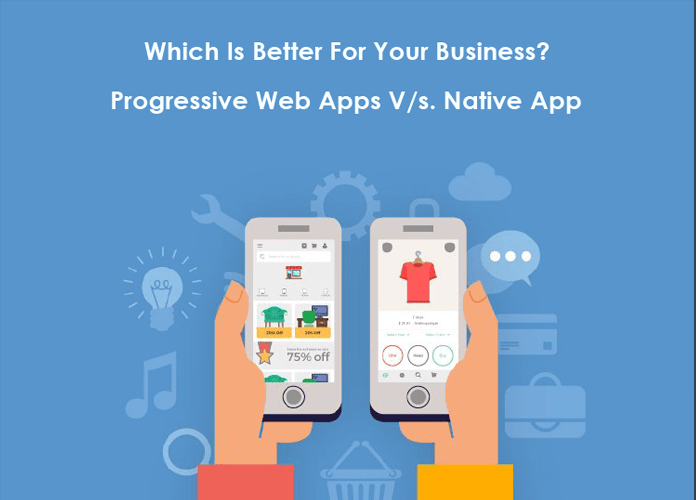Application Programming Interface (API) was used in the earlier stages Window NT and user mode application Native application is compiled by writing in languages such as Java, C#, or Objective –C.
Because of the ease and comfort of mobile devices, people spend more time on them for accessing the Internet and getting the required content through responsive web design. Alternatively, you may get it from an app store and add the same to the home screen of your mobile devices.
What’s PWA?
Progressive Web App (PWA) makes a mid-way approach between mobile apps and mobile websites. Built with the latest version of the JavaScript framework, PWA is a mobile site and works similarly to a native app.
They work against native APIs. Progressive Web Apps (WPA) can be rendered in a browser by using HTTPS. It may be included in the home screen for experiencing a full screen. Native apps need an app store and multiple steps for downloading.
Whereas Native Apps Development is limited to a single operating system and needs duplicate codebases, PWAs are so designed as to operate on any device in any browser.
You can get instant engagement on PWAs, whereas you need to put some extra effort into the Native App because it was pretty weak a few years ago. With the passage of time, people did not like the online features of Native App. They instead preferred the offline experience.
Fundamental Differences between Native App and PWA!
1. Installation
The end-users shop the Native App from Google Play or Apple’s iOS Store. Once installed on your mobile device, it will appear on your home screen. The content is indicated through a recognizable icon, along with a text label. Like a Native App Development Company, after developing a native app, you must submit the same to some app stores of your devices for displaying. We liked, the users download and save them on their home screen. The PWA, such as Financial Times, are web apps that run from inside the browser of the mobile device. You can be relieved of the administrative headaches involved in App Stores.
2. Cross-Platform Availability
As the Native Apps Development Company designs the apps to suit Android or iOS users, you get tailor-made platforms. Therefore, as a developer, you need to worry less about platform compatibility or cross-browser-compatibility. You have the opportunity of creating a more user-friendly experience. Alternatively, PWA is more progressive, versatile, and innovative. The web developers publish a responsive PWA example that is displayed rightly inside the parameters of the screen. A variety of mobile browsers can keep engaged with just one app. There can be significant savings on cost and time.
3. Offline Usage:
If you have a mobile app, you can have access to certain information without getting connected to the Internet. The once prerogative of the app is now getting divulged to the web as well. PWA is a web-based app. So, once installed, you can work offline by utilizing the cached data. Service workers are files written Java Script and run independently of the web app itself. They enable offline use in PWAs and improve the features and performance by
- Handling network requests,
- Fetching cached resources,
- Caching app resources,
- Enabling push messages, even the user is offline
However, PWA has certain constraints in serving certain parts of the app to web users when they are not connected to a network. These parts are the natural caching system of the page and are not available until the internet connectivity is restored.
4. Storage, Power, and Data
When installed to the desktop of a mobile device, a native app, it pulls from the resources of the devices directly. Thus, if forgotten to be closed, the resource-heavy app will drain more battery, storage space, and mobile data. The same thing may happen for PWA if the app is not well-coded or how many resources the app calls are not known.
5. Updates
Updating for both native and progressive app has nothing much to do as automated updating does the job.
6. Discovery
For the following two chances, native apps may show themselves up in search results
- In search engines
- Within the App Stores
Since the pages of the app are not indexed, you need to adopt the tactics of App Store Optimization for the following.
- Identification of a commonly-researched keyword that applies to your mobile app and contains it in your app title and description.
- Make use of a secure title or headlines which includes your elected keyword
- Besides appealing to the app store user, make sure, they understand it
- Ask the users to leave their Customers’ ratings.
- The number of downloads should go up.
- Make your app specifically labeled with more niches. You can get a more relevant app store search
On the other hand, PWA, like any other website WAP, will do well concerning web research SEO. It also allows a higher volume of traffic for reaching your PWA compared to contact your PWA.
7. Push Notification
Compared to traditional methods such as emails, push notifications to attract more engagements, specific industries were getting up to% Click through Rates (CTR). You can integrate your current push notifications into a native app by using other notification services such as PushBots, Google Firebase or One Signal
8. Security
Mobile apps need to be GDPR compliant for both app owners and users. Multi-Factor Authentication can easily be used in a native app. Moreover, Native Apps can make use of certificate planning for preventing certain types of attacks that can’t be emulated by PWAs. Still, PWAs are served over HTTP that does not permit for browser-to-server encryption. It is as secure as any website.
9. Device Features
While building your application for placing on a user’s mobile device, it develops the ability to synchronize with other devices and telephone features. For instance; native apps can use cameras, accelerometer, GPS, Geo-fencing, Compass, Alarm, Contact List, Calendar, SMS and Push Notifications, Near-field communication, and mobile payment
PWAs don’t offer a particular set of features. They can be thought of as a tool kit that creates the potential for taking advantage of device features. You don’t need to add access to devise features. However, you can make some connections through APIs like social media logins for improving the user experience.
10. Cost
A native app is built with JavaScript for Android or with Objective-C or Swift for iOS. It takes a long time for development and gets duplicated for each platform. Moreover, the maintenance cost is very high. You may consider the cost of outsourcing that maybe $40 to $80 for a native app. Besides being a service app. PWA has service workers and needs replication of a lot of work. A native app will cost more than the progressive web app.
Conclusion
Which one you should opt for depends upon your need out of the technology. With the increase in technology, PWAs have specific good uses in large social media sites such as Twitter Lite and Pinterest. A native app will help in markets having poor or expensive connectivity. The small business that could afford a fully Native App can go in for PWA that would save time and would maintain apps on separate platforms.

